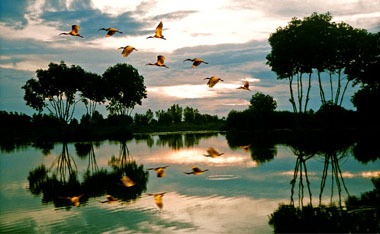Mũi Cà Mau National Park is a special nature reserve located in Ngọc Hiển district, Cà Mau province, at the southernmost point of Vietnam. The park was established to protect the unique ecosystems and biodiversity of the mangrove and coastal areas. Below are some detailed information about Mũi Cà Mau National Park:
1. Location and Area
Mũi Cà Mau National Park is situated at the southern tip of Vietnam, in Ngọc Hiển district, Cà Mau province.
The park covers an area of approximately 41,862 hectares, including mangrove forests, wetlands, and coastal areas.
2. Ecological Features
Mangrove Ecosystem: This is the dominant ecosystem in Mũi Cà Mau National Park, with various typical plant species such as mangrove trees, nipa palms, and saltwater plants. These plants play a crucial role in protecting the soil from erosion while also providing a habitat for various wildlife.
Marine Ecosystem: The park also has a rich marine ecosystem, with mudflats, river mouths, and brackish waters that are home to many aquatic species such as fish, shrimp, crabs, and other marine creatures.
Wildlife: Mũi Cà Mau is home to several rare and endangered species, including birds like herons, storks, cormorants, turtles, and notably, the freshwater crocodile. It is one of the key areas for wildlife conservation in the Mekong Delta region.
3. Culture and History
Mũi Cà Mau is not only a natural reserve but also holds significant historical and cultural importance, tied to the formation and development of the southern region of Vietnam.
The area is also home to the traditional cultures of the local communities, especially the Khmer people, who predominantly live in the Cà Mau region.
4. Tourism Activities
Mũi Cà Mau National Park attracts tourists not only for its pristine natural landscapes but also for eco-tourism activities such as visiting the mangrove forests, bird watching, fishing, and exploring the marine ecosystem.
Additionally, the park offers an opportunity to learn about the traditional livelihoods of local communities, such as forest planting, aquaculture, and salt production.
5. Conservation and Protection
Mũi Cà Mau National Park plays a critical role in environmental protection, preventing saltwater intrusion, and combating climate change.
Local authorities and conservation organizations are working to maintain and develop sustainable tourism models, providing opportunities for local communities to participate in the conservation of natural resources.
With its unique ecological features and rich cultural values, Mũi Cà Mau National Park was recognized by UNESCO as a Biosphere Reserve in 2009.



